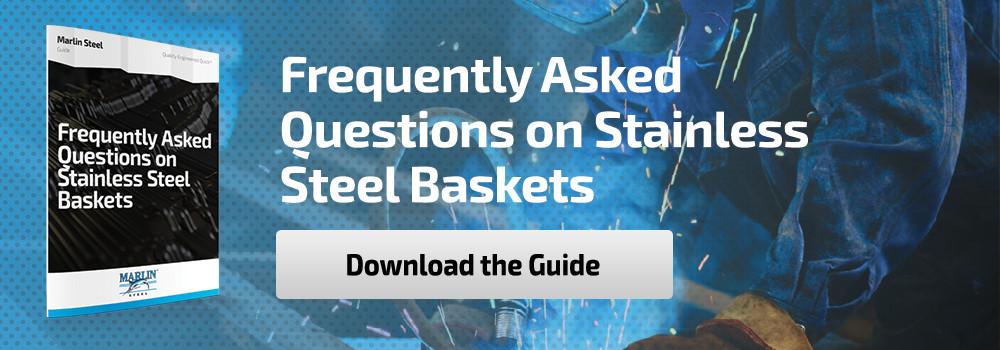 There’s more than one way to move a heavy load. Marlin Steel’s degreed engineers have been asked to create baskets that are compatible with a number of different means of movement, from conveyor belts, to hand carrying, to hoists and more.
There’s more than one way to move a heavy load. Marlin Steel’s degreed engineers have been asked to create baskets that are compatible with a number of different means of movement, from conveyor belts, to hand carrying, to hoists and more.
Recently, a client contacted Marlin for a quote about a custom parts washing basket to hold a set of heavy split gears through their washing process. Each load consisted of 30 separate 15-pound gears piled on top of each, or 450 pounds of weight randomly distributed.
Because of the sheer size and weight of these loads, the client had to move them using a forklift on pallets.
The client wanted to move from using pallets to using steel parts washing baskets to:
- Eliminate needless secondary handling; and
- Improve drainage for parts (dirt and runoff would sit on the pallets and re-deposit onto parts).
The improvement to drainage was especially important for saving the client time and money on having to rewash parts at the bottom of the pile.
Building the Ideal Heavy-Duty Parts Washing Basket for the Job
This task had several challenges that needed to be addressed:
- There was a heavy load specified, with randomly-distributed weight
- The basket had to be forklift-compatible
- The basket needed to be able to nest when empty
- The wash process used a set of rails to move the load along a mesh wash table
So, the basket had to be compatible with not one, but two methods of conveyance and strong enough to hold a massive load with unpredictable weight distribution while still allowing thorough drainage.
To make sure that the basket would meet the client’s needs, Marlin’s degreed engineers created a custom basket schematic using:
- Expanded metal rather than steel wire;
- Sheet metal tubes for forklift compatibility; and
- Four eye hooks to allow the basket to be guided along the client’s rail system during the wash process.
Why Use Expanded Metal for This Wash Basket?
 One of the biggest challenges here was that the loads being washed consisted of large, heavy parts that would be piled in rather than neatly spaced out and organized. This meant that Marlin’s degreed engineers couldn’t assume any kind of even distribution of weight.
One of the biggest challenges here was that the loads being washed consisted of large, heavy parts that would be piled in rather than neatly spaced out and organized. This meant that Marlin’s degreed engineers couldn’t assume any kind of even distribution of weight.
Basically, every square inch of the bottom of the basket needed to be tough enough to hold the majority of the load’s weight.
To achieve maximum strength from the material chosen for the task, Marlin’s degreed engineers opted to use expanded metal mesh instead of steel wires.
Expanded metal achieves a higher tensile strength than steel wire with the same material thickness. This is because, although there are holes in it, expanded metal is one continuous piece of material with no weld joints or other structural weaknesses.
In addition to offering higher tensile strength, expanded metal reduces the total number of welds that need to be made in the parts washing basket.
The only drawback to using expanded sheet metal in this case was that the flatter surfaces of the sheet metal are slightly more prone to retaining some runoff than the rounded surfaces of steel wires. However, this risk was insignificant compared to the benefits.
Ensuring Forklift and Rail Compatibility
To make sure that the basket was forklift-compatible, Marlin’s degreed engineers added three large sheet metal tubes to the bottom of the basket’s design.
These tubes were built to be easily large enough to accommodate the tines of a forklift. Additionally, these sheet metal tubes ran perpendicular to the sheet metal cross plate running along the middle of the basket’s bottom—adding extra structural support for the expanded metal mesh.
Four eye hooks were then added near the corners of the top frame of the basket to ensure compatibility with the in-wash rail system. Each eye hook was secured using a flare bevel groove MIG or TIG weld to hold it fast to the outside of the sheet metal frame.
In addition to making the basket compatible with the client’s rail system, these eye hooks serve as guides for nesting the baskets when they’re not fully loaded. The sheet metal tubes also assist with this, being cut slightly shorter than the frame so the basket can nest smoothly.
By taking into account all of the client’s needs and the specifics of the parts washing process, Marlin’s degreed engineers were able to create a custom parts washing basket that saved the client time and money.
Need a custom basket for your highly-demanding parts washing process? Contact an experienced mechanical engineer for a consultation today!



.gif)


